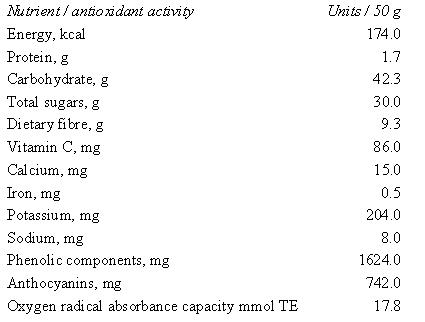Blueberries are a good source of phenolic compounds, and evidence suggests that plant polyphenols may reduce the risk of cardiovascular disease. In particular, blueberries are rich in anthocyanins (93 to 235 mg / 100g berries), a sub-group of flavonoids that are known to have strong antioxidant effects in vivo. Phenolic compounds make good antioxidants because they are able to donate hydrogen atoms to oxidised compounds in scavenging reactions. Blueberries have been shown to lower blood pressure, decrease inflammatory, protect against obesity, improve insulin resistance and modulate plasma phospholipids levels favourably, which suggests they may be effective in the treatment of metabolic syndrome. Blueberries also contain significant levels of some micronutrients as well as fibre, which may contribute to their favourable effects. The nutrient content of freeze dried blueberries is shown in figure 1.
Figure 1. The nutrient content of freeze dried blueberries1
To investigate the effects of blueberries on the features of metabolic syndrome, researchers1 fed 48 obese men and women (BMI 37.8 kg/m2) 50 g of freeze dried blueberries per day or a control. After 8 the researchers tested the subjects for body weight and shape changes, blood pressure and fasting glucose levels. The bodyweight, waist circumference, HbA1C, insulin resistance, serum glucose concentration and lipid profiles did not differ between the control and the treatment groups. However, consumption of blueberries did result in a reduction in diastolic and systolic blood pressure (-6 % and -4 %) greater than controls (-1.5 % and -1.2 %). In addition, subjects consuming the blueberries had a decrease in oxidised LDL (-28 %) and a decrease in combined malondialdehyde and hydroxynonenal concentration (-17 %), compared to the controls (-9 % and -9 % respectively).
The freeze dried blueberries used in this study (50 g) are equivalent to around 350 gram of fresh berries. With this amount of berries, decreases in blood pressure took just 8 weeks with no other intervention. If a pharmaceutical drug had achieved these results it would be seen as highly effective, considering the lack of side effects from consuming fruit. Smaller quantities of berries may have similar effects but this was not tested. However, one might expect the time period for blood pressure changes to occur to increase if less berries were consumed. Blueberries are freely available commercially both fresh and frozen and can also be consumed in drinks or jam. Autumn is also the perfect time to stock the freezer with fresh berries from hedgerows and woods. Berries in general are a rich source of anthocyanins and similar cardioprotective effects have been recorded in other types of berry.
RdB

